August 30, 2017 – Volume 19, Issue 6: Red Light Cameras
In This Issue
Flanigan’s Eco-Logic: Red Light Cameras
Here Come the Electric Ferries
“Reggie” Doubles Down in New England
Grid Reliability
Transit Etiquette
Stanford Reaches for the STARS
Telltale Signs of Climate Change
EcoMotion Intern Perspectives

Flanigan’s Eco-Logic: Red Light Cameras
So I ask you: Is it me getting old and more conservative, or are there more and more people running red lights? And if it’s the latter, and there is more red-light running, won’t there be a lot more crashes?
Or do we all adjust to this tardy behavior? Do we as a society learn to wait a few seconds more when the light turns green, and make sure to look left, and right, before proceeding? Is this because green may not be green at all? Do we need another light to tell people to really stop? How about a double red? Or should orange to be the new red? Some cities extend the yellow a bit with marked results.
Why aren’t cameras the answer? In this day and age, it would seem that yes, only real-time ubiquitous cameras backed up with stiff fines would be the only way to change red-light-running behavior. Red light cameras were removed years ago in California cities, in 2012 where I live; 2013 where I work. Why? Seems that cameras are an integral part of 21st-century security systems. Cameras don’t lie.
Automatic ticketing programs use cameras mounted at intersections that automatically record all cars that are in violation of the red light law. Drivers then get tickets by mail. The use of red light cameras has been challenged as a taking of civil liberties, criticized as “big brother” like. But let’s see: You’re running a red light and could potentially kill people. How many civil liberties do you deserve?
Traffic deaths rise when cities remove cameras… up by 30% according to the Institute for Highway Safety. Its study surveyed 158 communities that removed their cameras, focusing on a sample size of 14 and a control group of 29 cities in the same region that kept their program. Related research found that fatalities were 21% lower in cities with cameras. Hmmm.
The origin of green, yellow, and red traffic signals dates back to 1830s when the system was devised for railroad traffic. Red was chosen as it symbolizes danger. Originally white was used for “go.” (Green symbolized caution.) The use of white ended when several red lenses broke, leaving exposed light bulbs naked and white… and sending the entirely wrong signal.
In the 1860s and in England, increased volumes of horse-drawn traffic warranted the development of a “sephamoric” system, like a railroad crossing using an arm that raised and lowered, the latter to stop. The sephamoric system also included red and green lights for nighttime stop and go. Then in the 1920s, and in Detroit, a policeman named Potts invented the three-lamp traffic signal that is standard today.
So is it just me? Is it just my town? I read a bit and find a reporter writing that running red lights is practically a “municipal pastime” in Reno. There’s a band called the Running Red Lights in Toronto. A self-driving Uber was found running a red light in San Francisco. In St Louis County a top official there called running red lights the “the most pressing traffic issue.” Red-light running is a top cause of auto accidents.
Opponents have claimed that red-light cameras are all about raising money. They are reinforced in their objection by studies that show that red-light cameras cause an increase in rear-end collisions as motorists slam on the brakes to avoid being ticketed. This was the justification for a bill introduced in 2015 in the California Assembly (AB 1160) to ban all such programs that use red light cameras in California. “They’re a hindrance to traffic,” was the rallying cry.
OK, there is data that shows that rear-end collisions went up 80 – 325% at select intersections where cameras were installed. My response: For how long? Give the cameras time to work. Let drivers get used to a new reality, a reality of very stiff fines. They will change. In time they will learn to slow down as soon as they see yellow and prepare to stop.
So what happened? On no, the story leads us to the courts. Ugh. In our neck of the woods, the L.A. County courts refused to prosecute vehicle owners who refused to pay their violation notices, typically $480. The courts put photo evidence in question. The State Court of Appeal, Second District court issued seemingly contradictory rulings. In the meantime, only volunteers paid their fines, and cities were only breaking even after paying taxes and fees to firms like Redflex, an Australian firm that installed and operated systems.
First introduced in the 1980s, by 2014 there had been a large drop in their use. In the 2012 – 2013 time frame, many Southern California cities abandoned their programs and took their red light cameras down. My hometown of Glendale dropped its Redflex system in 2012. In California, 60 cities dropped their camera programs. Nationally, there was a drop from 700 cities nationwide to 500 by the end of 2013. San Diego, El Cajon, Walnut, Murrieta, San Bernardino, Los Angeles, and Pasadena all canceled their programs. Pasadena canceled its red-light camera program in 2012 and also increased the yellow time at its traffic signals. A Texas Transportation Institute study found that a one second increase in yellow decreases accidents by 40%. West Hollywood added three-tenths of a second to its lights.
So what’s the goal? It is to get drivers to stop when the light turns red. Simple. Could we try a carrot approach? Doubt it. Here’s where a big stick is good, where a big stick can save lives. By being firm in our use of today’s most basic security technology – the camera – there can be fewer deaths and injuries on our roadways. We can change bad behaviors.
Definition of the Week:
man·spread·ing, ?man?sprediNG/ noun, informal: The practice whereby a man, especially one traveling on public transportation, adopts a sitting position with his legs wide apart, in such a way as to encroach on an adjacent seat or seats.
Here Come the Electric Ferries
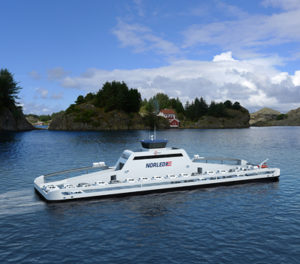 Siemens has a long track record with electric boats. Fully 130 years ago, Siemens launched its first electric boats on the Spree River in Berlin. They operated as water taxis in 1886; each Elektra could carry 25 passengers at a speed of 9 mph.
Siemens has a long track record with electric boats. Fully 130 years ago, Siemens launched its first electric boats on the Spree River in Berlin. They operated as water taxis in 1886; each Elektra could carry 25 passengers at a speed of 9 mph.
For more than 90 years, Siemens has provided electric boats to Bavaria’s Konigsee region. Prince-Regent Luitpold of Bavaria feared that the noise created by combustion engines would scare off wildlife in his hunting grounds along the lake. So electric boats replaced row boats. And they still operate to this day: 110-volt motors with an output of 9 kW and an average speed of 7 mph. Each boat travels about 75 miles per day of operation, consuming almost 80% of its battery.
The Ampere crosses the Sognenfjord
Source: Siemens
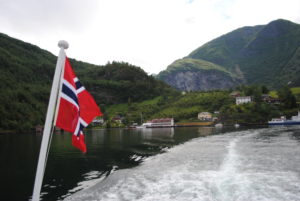
Crossing the Sognenfjord
The all-electric ferry, called Ampere, was built by Fjellstrand shipyard. It uses three lithium-ion battery packs to power the ship, one on board and one at each pier. Their combined capacity of 1 MWh provides for 10 minutes of recharging between each run; the battery packs at each pier mollify the effect of drawing that much power in the remote areas and relatively weak utility infrastructure.
While carrying ten tons of batteries, Ampere was built to be lightweight. Made of aluminum, not steel, it is half of conventional ferries’ weight. And the corrosion-free aluminum needs no paint, thus less weight and maintenance. The ferry is powered exclusively by hydroelectricity from the region… saves 260,000 gallons of fuel annually, and avoids the emissions of 2,680 tons of CO2 and 37 tons of nitrogen oxide. Such electric ferries could operate profitably on up to 50 similar routes in Norway.
Now the State of Washington is getting into the action, led by Skagit County. It plans to replace its diesel-powered Guemes Island ferry – a “clunker” with heavy maintenance and fuel costs — with a battery-powered, zero emissions one. The ferry goes a half-mile each way, resulting in savings of 620 tons of GHG per year, like taking 132 cars off the road and making it the first all-electric ferry in the nation.
One of the advantages of the electric ferries is that the quieter engines will decrease underwater noise, making them “Orca-friendly.” Several factors are threatening Orcas’ survival including declining prey, chemical contaminants, and rising underwater noise levels. Quieter ships will support Orcas’ ability to locate ever-more scarce Chinook salmon and to communicate with each other.
Now Washington State Ferries is studying the conversion of some or all of its 22 vessels. Many ferries already have electric motors, with diesel generators feeding them, making it relatively simple, in cases, to replace the diesel generators and their fuel tanks with batteries.
“Reggie” Doubles Down in New England
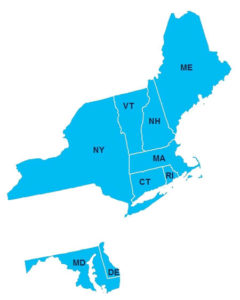
RGGI States
The nine Northeastern and MidAtlantic states of the Regional Greenhouse Gas Initiative (RGGI) announced in late August that they have agreed on a proposal to continue to use cap and trade program and to cut GHGs from the region’s power plants by an additional 30% between 2020 and 2030.
The extension of “cap and trade” in New England has been seen as a test case for how states will continue their focus on climate protection. The RGGI states, together represent the world’s sixth largest economy, with $2.8 trillion in GDP. California – which recently extended its program is slightly smaller, a $2.5 trillion economy. “With the Trump administration making every effort to turn back the clock of environmental progress, it falls to state and regional collaboration to lead the way in protecting public health and defending clean air and water,” noted Conservation Law Foundation attorney Phelps Turner.
RGGI got bipartisan support for its new goals, goals that will lower emissions caps by 3% over the previous year versus the current plan’s 2.5% drop. If the proposal is approved and enacted, GHG emissions in the RGGI compact will be 65% lower in 2030 than they were in 2009. Already, according to an Acadia Center study, emissions have fallen more than 40% compared to 2008 levels.
Under the RGGI model, the coalition sets a cap on carbon pollution that declines each year. Each year, the states sell a decreasing number of permits – or allowances — at auction. Power plant operators purchase the allowances or trade them in the marketplace, enabling them to remain under the cap. The proceeds from the auctions are rolled into energy efficiency and renewable energy initiatives and programs.
Grid Reliability
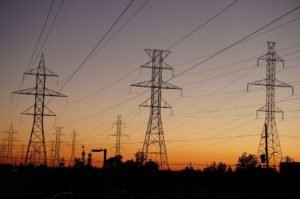 U.S. Secretary of Energy Rick Perry sent a memo to staff in April of this year seeking clarity and a review of, “how market-distorting policies are potentially threatening the reliability of the grid.” Many renewable energy advocates feared that this would be another attempt to undercut de-carbonization strategies, another way to intercede the widespread adoption of disruptive technologies, such as rooftop solar power. Perry also stated that he might intervene in states with strong renewable policies, states that advocate for “variable renewable energy.”
U.S. Secretary of Energy Rick Perry sent a memo to staff in April of this year seeking clarity and a review of, “how market-distorting policies are potentially threatening the reliability of the grid.” Many renewable energy advocates feared that this would be another attempt to undercut de-carbonization strategies, another way to intercede the widespread adoption of disruptive technologies, such as rooftop solar power. Perry also stated that he might intervene in states with strong renewable policies, states that advocate for “variable renewable energy.”
But the final version of the report released last week does not condemn renewables. In fact, it affirms that grid operators have said they are facing no difficulty in managing an increasingly diverse set of resources and the modernization of the electric power system. The report, which got lots of press, noted rightly that low, natural gas prices have been the primary driver in coal and nuclear plant retirements and cancellations. Contradicting prior claims made by the Secretary, wind and solar are indeed creating news jobs and are not a threat to grid reliability. The United States can safely operate the electric grid with high levels of renewables.
While generally pleased and relieved with the report’s findings, critics note that it fails to link climate change with grid vulnerability and reliability. It fails to report the huge societal benefits of renewables, nor the gross subsidies fossils and nuclear have received for years. But the fundamental truth is something that Perry could not wipe out… that diversifying a power portfolio – like an investment portfolio – increases reliability.
Transit Etiquette
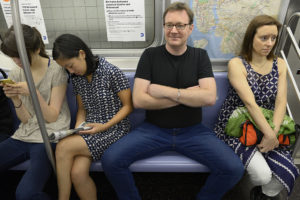
Man-spreading in action
Photo Credit: Richard Yeh/WNYC
Ever heard of “man-spreading?” That’s when a man on a train spread his legs wide taking up several seats, and making potential seatmates unusually and understandably uncomfortable…Transit etiquette is a much needed in LA. Transit ridership throughout the “Southland” is down, in part because of rude behavior on LA’s buses and trains.
During a five-week surge on the Blue Line in LA that connects the downtown with Long Beach, sheriff’s deputies and Metro security warned 3,280 people, cited 55, and ejected 2,064. There were 681 incidents of riders taking up excessive space, second only to people eating and drinking, at 745. Other infractions included: sleeping on a bench, 554; playing loud music, 275; offensive behavior, 116 and other, 572.
There are lots of Dos and Don’ts when it comes to transit etiquette. Basically, don’t be a jerk…. Don’t be one of those passengers that leave all others cringing! And don’t be the cop! Don’t make things worse for you by confronting rude behavior. Just be the example.
There are ways of being truly admirable: Give your seat up to those really in need. Stand right, walk left on escalators. Let passengers exit the train; do not block them! This is all about moving people efficiently and safely.
And then there are things not to do: Fare evasion. Obnoxiously chatting on the cell phone. Letting your carry-ons bang into other passengers as you walk down the aisle. Don’t douse yourself in perfume. There’s no eating or drinking on board. Smoking and vaping are out! And yes, there is no loud music on board. You can’t put gum or your feet on the seats, kinda like home! And despite how cool it may be… please refrain from making lewd remarks.
Metro riders who commit repeat offenses can be banned from the system for 30 to 90 days.
Stanford Reaches for the STARS…

Source: Stanford University
Stanford University in Palo Alto, California, founded n 1885, has become the second university to reach the Platinum STARS rating as developed by AASHE, the Association for the Advancement of Sustainability in Higher Education. Stanford, with 7,032 undergraduates and 9,304 graduate students, now joins Colorado State University in this highest level of sustainability distinction.
Stanford’s fourth STARS submission presents recent advances in sustainability on campus including solar on 15 campus buildings. It also includes the Stanford Solar Generation Station, a 67 MW, 200 acre, off-campus solar farm interconnected in December, 2016 in Kern County, CA. It provides 53% of Stanford’s power requirements. Other advances include expanded student, staff and administration opportunities for sustainability, an ever-increasing number of sustainability courses, and the My Cardinal Green Program that was launched in May, 2017 that encourages individual action in environmental conservation.
Launched in 2009, STARS is a widely recognized framework for publicly reporting comprehensive information to higher education sustainability performance. Over 800 participating colleges and universities, spanning six continents… report achievements in academics, campus and community engagement, operations, and planning and administration.
Telltale Signs of Climate Change

Hurricane Harvey
In this issue we report on three telltale signs of climate change: Hurricane Harvey, Shrinking Permafrost, and Arctic Shipping:
Hurricane Harvey: Let’s begin with Harvey, still nailing the Texas Gulf coastline as I write. According to 350.org, “Hurricane Harvey is an unnatural disaster… it is the product of a hotter planet….” It is also a function of rising sea levels, warmer oceans that mean more rain, and stronger winds from the warmer ocean to boot. Sea levels are about a foot higher than 1960. The gulf was 4- 7 degrees hotter than usual, well above 80 degrees. The devastation is unparalleled.
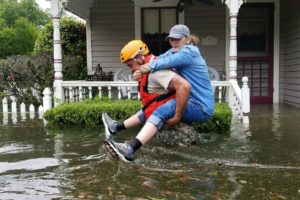
Source: Department of Defense
There is some bright news: 21 convenience stores and gas stations in the Houston area remained open thanks to their microgrids designed and installed by Texas firm, ERock. The systems use natural gas generators at commercial sites that island to form microgrids, allowing the stores to provide essential services like water, food, and gasoline. Care is being taken to make sure that microgrids do not energize flooded stores. Another noted microgrid and Hurricane Harvey survivor is the Texas Medical Center thanks to its combined heat and power system. It is one of the world’s largest medical centers… 20 million square feet in size.
Permafrost: Permafrost, it ain’t permanent anymore. It’s thawing. And the ancient carbon it’s dumping into the atmosphere will make things even warmer, report researchers from the Woods Hole Research Center. Permafrost is the frozen layer of soil and ice that underlies much of Alaska, some of which has persisted since the last ice age, more than 10,000 years ago. And it is melting rapidly. As the earth warms, and the Arctic warms especially fast, the permafrost melts and soil decomposition accelerates… a vicious cycle of more and more emissions.
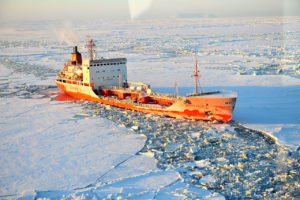
A Russian tanker plows through the Arctic
The Arctic is warming about twice as fast as other parts of the planet. Sea ice and wildlife habitat are disappearing. Researchers say that the thawing of the permafrost — the “always-frozen ground” that underlies much of Alaska — could raise temps by 1.7 degrees F over the next few centuries. When the permafrost’s organic material thaws, microbes convert some of it to carbon dioxide and methane. Experts claim that the current IPCC targets do not account for this factor. An IPCC report suggests that there could be as much as 205 gigatons of GHGe released due to melting permafrost – four times the annual emissions of GHGs worldwide.
Arctic Shipping: Due to climate change, and warmer Arctic conditions, a new global shipping route is now possible. New freighters are being designed and built that can plow through the ice – without the assistance of an ice breaker – to lessen the time spent transporting goods. Shipping routes once thought impossible may open up by mid-century. Arctic ice melting fast; it has declined sharply each decade since the 1980s… from 3,302 cubic miles of ice to a projected 1,480 cubic miles by 2030, then 737 by 2060. This opens up a more direct route between Asia and ports in Europe and Eastern North America… versus southern routes that use the Suez and Panama canals.
Now a specially constructed, Russian-made LNG tanker has crossed the Arctic Ocean in record time. The Christophe de Margerie completed a journey from Norway through the Arctic to South Korea in just 19 days, much faster than if it had followed the traditional route through the Panama Canal. And it required no icebreaker escort and uses LNG fuel.
The first of a class of new tankers, the ship has an internal icebreaker that can push through ice that is 4 feet thick. The ship cost $300 million to build and was specifically designed to take advantage of the fact that sea ice is thinner than it has ever been. Russia is planning 14 such vessels, Russia expects Arctic shipping to increase ten-fold by 2020, avoiding the use of pipelines in unstable Middle Eastern countries.
EcoMotion Intern Perspectives
 EcoMotion has had many interns, about 50 over the past decade, mostly from the University of California at Irvine. Most recently and for the summer, we’ve been lucky to have Eric Getz and Ellen Lee on board. Eric is now in his final year at the University of Southern California; Ellen recently graduated from UC San Diego. These, I can personally attest, are quality students of sustainability. And they keep us on our toes!
EcoMotion has had many interns, about 50 over the past decade, mostly from the University of California at Irvine. Most recently and for the summer, we’ve been lucky to have Eric Getz and Ellen Lee on board. Eric is now in his final year at the University of Southern California; Ellen recently graduated from UC San Diego. These, I can personally attest, are quality students of sustainability. And they keep us on our toes!
Eric has a special interest in mobility. He was on his high school’s solar race car team; then he’s been working on a Hyperloop submission with fellow students at USC. He helped EcoMotion with several projects this summer -including creating a database of Southern California solar companies – and also dug into electric buses. “I had no idea of how big a deal electric buses are,” said Eric. “E-Buses are coming on fast and seem to be taking over the market.” Eric completed a white paper on E-Buses that is available at: https://ecomotion.us/transit-buses-the-advent-of-electrification/

